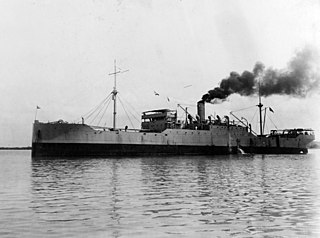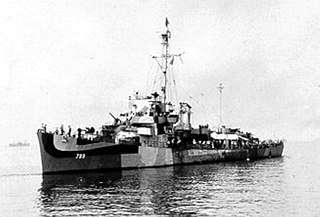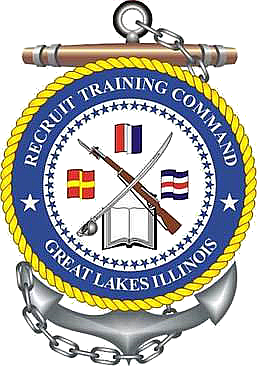
Kamikaze, officially Shinpū Tokubetsu Kōgekitai, were a part of the Japanese Special Attack Units of military aviators who flew suicide attacks for the Empire of Japan against Allied naval vessels in the closing stages of the Pacific campaign of World War II, intending to destroy warships more effectively than with conventional air attacks. About 3,800 kamikaze pilots died during the war in attacks that killed more than 7,000 Allied naval personnel, sank several dozen warships, and damaged scores more.

USS Oriskany (CV/CVA-34),, was one of the few Essex-class aircraft carriers completed after World War II for the United States Navy. The ship was named for the Battle of Oriskany during the Revolutionary War.

USS Langley (CV-1/AV-3) was the United States Navy's first aircraft carrier, converted in 1920 from the collier USS Jupiter, and also the US Navy's first turbo-electric-powered ship. Conversion of another collier was planned but canceled when the Washington Naval Treaty required the cancellation of the partially built Lexington-class battlecruisers Lexington and Saratoga, freeing up their hulls for conversion to the aircraft carriers Lexington and Saratoga. Langley was named after Samuel Langley, an American aviation pioneer. Following another conversion to a seaplane tender, Langley fought in World War II. On 27 February 1942, while ferrying a cargo of USAAF P-40s to Java, she was attacked by nine twin-engine Japanese bombers of the Japanese 21st and 23rd naval air flotillas and so badly damaged that she had to be scuttled by her escorts. She was also the only carrier of her class.

USS Forrestal (CVA-59), was a supercarrier named after the first United States Secretary of Defense James Forrestal. Commissioned in 1955, she was the United States' first completed supercarrier, and was the lead ship of her class. The other carriers of her class were USS Saratoga, USS Ranger and USS Independence. She surpassed the World War II Japanese carrier Shinano as the largest carrier yet built, and was the first designed to support jet aircraft.

USS Charles R. Ware (DD-865), was a Gearing-class destroyer of the United States Navy in service from 1945 to 1974. After her decommissioning, she was sunk as a target in 1981.

USS Montpelier (SSN-765), a Los Angeles-class submarine, is the third ship of the United States Navy to be named for Montpelier, Vermont. The contract to build her was awarded to Newport News Shipbuilding and Dry Dock Company in Newport News, Virginia on 6 February 1987 and her keel was laid down on 19 May 1989. She was christened 6 April 1991, launched on 23 August 1991 sponsored by Mrs. Nancy Hayes Sununu, and commissioned on 13 March 1993 with Commander Victor Fiebig in command.

Kaiten were crewed torpedoes and suicide craft, used by the Imperial Japanese Navy in the final stages of World War II.

USS Sable (IX-81) was a United States Navy training ship during World War II, originally built as the passenger ship Greater Buffalo, a sidewheel excursion steamboat. She was purchased by the Navy in 1942 and converted to a training aircraft carrier to be used on the Great Lakes. She lacked a hangar deck, elevators, or armament and was not a true warship, but she provided advanced training of naval aviators in carrier takeoffs and landings.

USS Bowers (DE-637/APD-40) was a Buckley-class destroyer escort of the United States Navy, was named in honor of Ensign Robert K. Bowers (1915-1941), who was killed in action aboard the battleship USS California during the Japanese attack on Pearl Harbor on 7 December 1941. The ship was laid down on 28 May 1943 at San Francisco, California, by the Bethlehem Steel Company; launched on 31 October, sponsored by Mrs. Eunice Bowers, the mother of Ensign Bowers; and commissioned on 27 January 1944. The ship served in World War II in the Pacific
USS Roselle (AM-379) was an Auk-class minesweeper acquired by the United States Navy for the dangerous task of removing mines from minefields laid in the water to prevent ships from passing. She was the second United States Navy warship to be so named.
USS Pilot (AM-104) was a United States Navy Auk-class minesweeper that saw service in the Mediterranean and Pacific Theaters of Operations during World War II.

USS Huse (DE-145) was a U.S. Navy destroyer escort launched by Consolidated Steel Corp., Orange, Texas on 23 March 1943, during World War II. The ship was sponsored by Mrs. L. M. Humrichouse, daughter of Admiral Harry McLaren Pinckney Huse, whom the ship was named after and commissioned on 30 August 1943.

USS J. Richard Ward (DE-243) was an Edsall-class destroyer escort built for the U.S. Navy during World War II. She served in the Atlantic Ocean the Pacific Ocean and provided destroyer escort protection against submarine and air attack for Navy vessels and convoys. She was named in honor of James Richard Ward who was awarded the Medal of Honor posthumously for his heroic efforts under fire on the USS Oklahoma (BB-37). She was launched by Brown Shipbuilding Co., Houston, Texas, 6 January 1943; sponsored by Miss Marjorie Ward, sister of Seaman First Class Ward; and commissioned 5 July 1943.

USS Procyon (AG–11) was an Antares-class cargo ship in the United States Navy after World War I. She later served as a training vessel for the Merchant Marine Academy as Empire State. In 1940 the ship was returned to the United States Maritime Commission, was renamed American Pilot, and sailed under the American flag during World War II. She was scrapped in 1948.

USS Scroggins (DE-799) was a Buckley-class destroyer escort in service with the United States Navy from 1944 to 1946. She was scrapped in 1947.

The Recruit Training Command, Great Lakes, is a command unit within the United States Navy primarily responsible for conducting the initial orientation of incoming recruits, also known as boot camp and recruit training, or RTC. It is part of Naval Service Training Command. It is a tenant command of Naval Station Great Lakes in the city of North Chicago, Illinois, in Lake County, north of Chicago.

USS Beverly W. Reid (APD-119/LPR-119), was a United States Navy high-speed transport in commission from 1945 to 1947 and from 1967 to 1969.

The Last Ship is an American action drama television series, loosely based on the 1988 novel of the same name by William Brinkley. The series premiered on TNT on June 22, 2014, and concluded after five seasons on November 11, 2018.